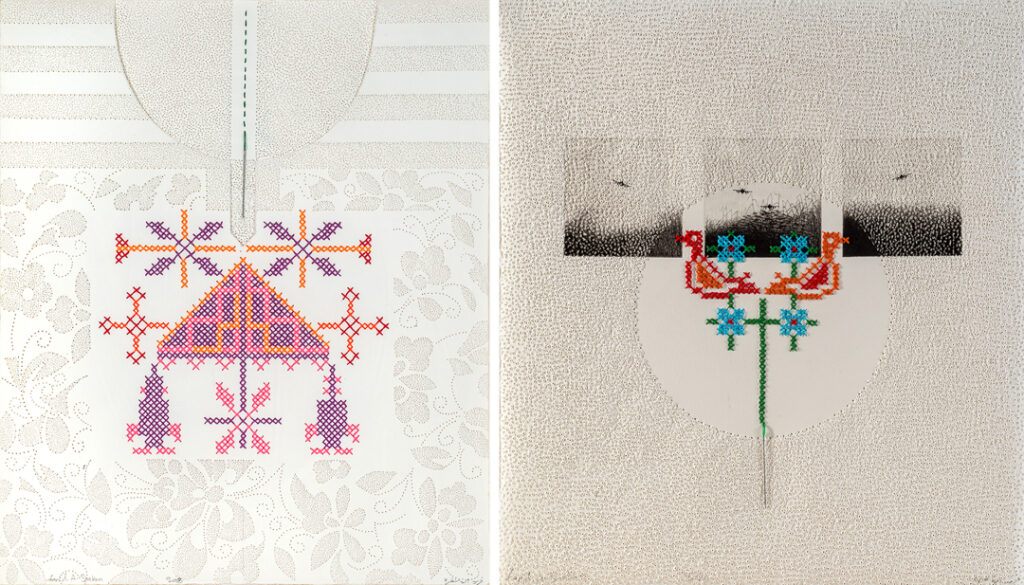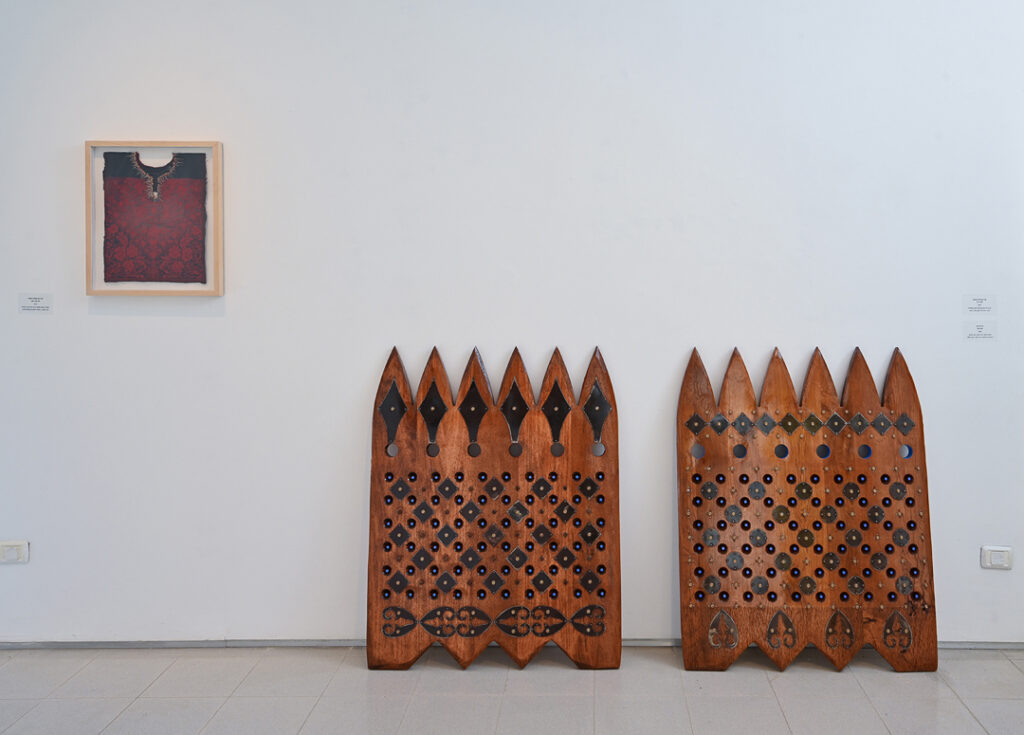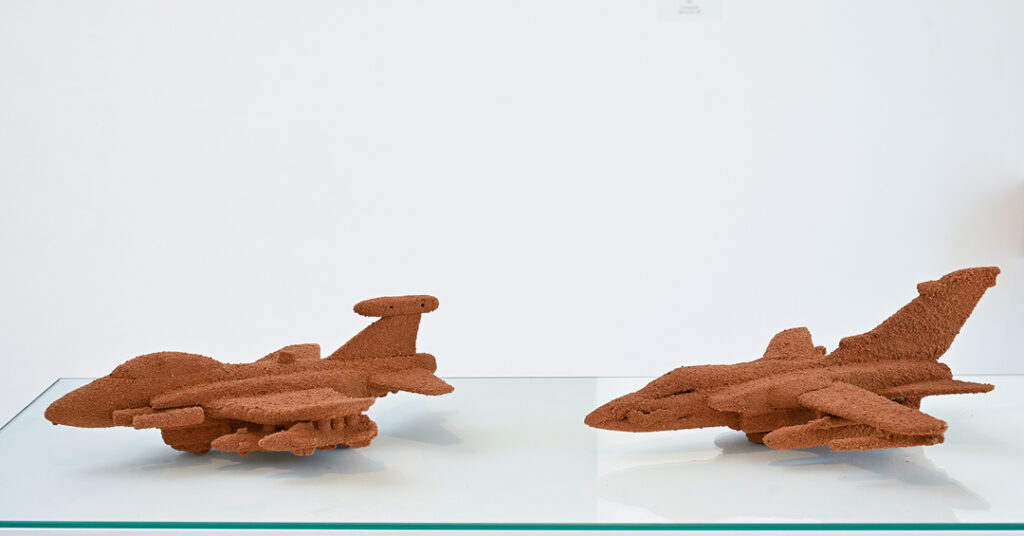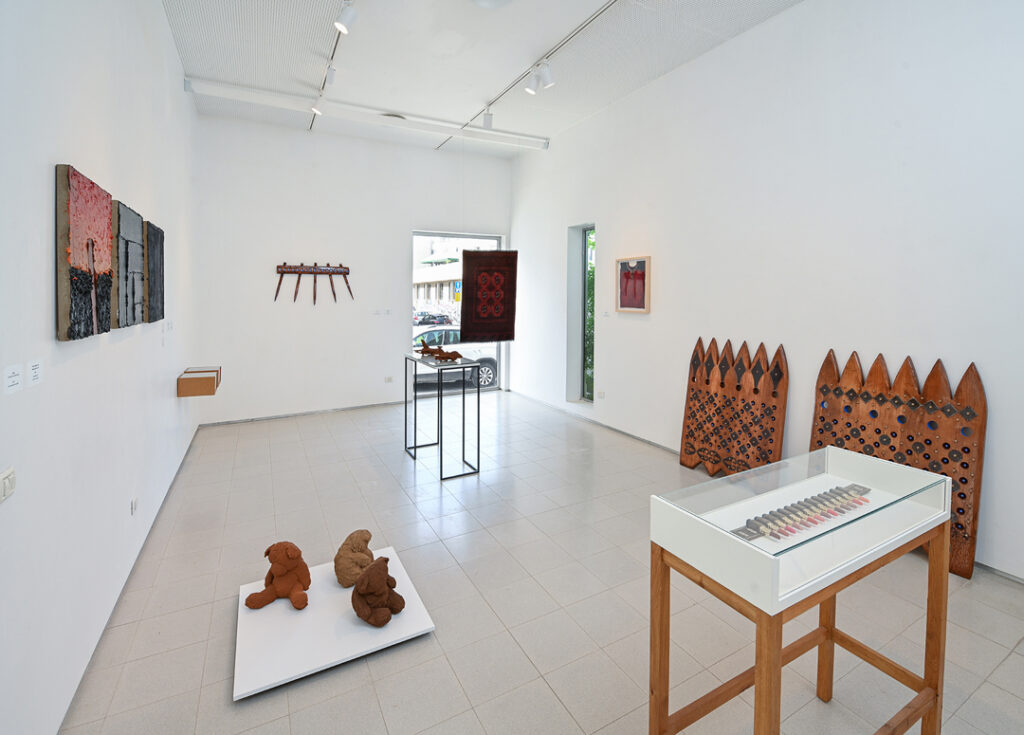- Farid Abu Shakra, Embroidered Chest, 2021, perforated paper, embroidery and needle. Photo: Igal Fardo
- Farid Abu Shakra, Two Plows, wood, iron acrylic and industrial paint. Photo: Shay Ben Efraim
- Farid Abu Shakra, Earth Shoes, soil casting and cactus thorns. Photo: Shay Ben Efraim
- Farid Abu Shakra, Earth Toys Warplanes, mix media. Photo: Shay Ben Efraimr
- Farid Abu Shakra, General view of the exhibition. Photo: Shay Ben Efraim
The curator Shlomit Bauman and the artist Farid Abu Shakra seek a common humanity.
A look at the works of Farid Abu Shakra in the exhibition GROUND? mark his territory of action, as an artist who is not afraid to face his foreignness as a Palestinian artist living in Israel, and the traditional patriarchal society in which he lives in the city of Umm Al–Fahem, the biggest Muslim town in Israel. Like geological research, Abu Shakra deciphers the different layers of the concept of “soil”, as agricultural tools become almost ritual objects, and at the same time creates an essential connection between his works and laborious craft. This laboriousness is expressed in actions such as wood carving, metal inlay, embroidery, perforation and creating earthworks. Like agricultural work (ploughing or sowing), these activities require Sisyphean, precise and repetitive work that is highly skilled with a deep understanding of material and wisdom of hands.
The series of works Embroidered Chest creates a direct connection between laborious tradition and contemporary creation: the process begins with perforating the paper backing of the embroidery. The piercing itself creates a new ornamental rhythm and within the different worlds meets pigeons, ducks and chickens combined with traditional cross stitches embroidered by Abu Shakra including actual embroidery cut from traditional Palestinian dresses. Warplanes emerge from the delicate embroidery and perforated paper and the hardworking, laborious embroidery needle becomes a painful thorn on the edge of the embroidery from a 1950s Palestinian dress. One of the most interesting works in this context is a prayer rug with thousands of almost invisible pins that echo its ornamental pattern. The “Prayer Rug”, a warm but “thorny” everyday object, embodies the complexity between attraction to it and rejection of it.

Farid Abu Shakra, Explosive Belt, lipstick, leather, cardboard, glue and threads. Photo: Shay Ben Efraim
The discussion of gender is strongly represented in Abu Shakra’s work: the “masculine” and the “feminine” merge, swap roles, and demand redefinition on a non-binary spectrum. The work “Ammunition Belt” and the embroidery work done by a man are essential meeting points between male and female identity. The belt, hand-sewn with rough stitches, contains a palette of lipsticks: on the one hand the figure of the warrior or hunter, and on the other hand ornamentation and beauty.
The earthworks in the exhibition are loaded with questions about place and locality, and questions about parallel narratives, the Israeli and the Palestinian.
The shoes of a girl made from earth adorned with thorns from the cactus bush, small models of earth warplanes, and three earthy teddy bears are not child’s play – although at first glance they may be recognized as a game, the second glance reveals that this gameplay is only in appearance.

Farid Abu Shakra, Lands: Umm ElFahem, Hadera, and Kibbutz Kabri, soil casting. Photo: Shay Ben Efraim
The work “Land: Umm Al-Fahem, Hadera, and Kibbutz Kabri” (three bears from soil) corresponds to the project from the early 1970s “Metzer-Messer”, in which artists such as Avital Geva, Micha Ullman, Moshe Gershuni, Efrat Natan, Dov Or-Ner and others, initiated a series of actions, including earth exchanges between Kibbutz Messer and the village of Maysar, burying waste received from residents of both communities in a 20-meter-deep pit, and other works in this spirit. From today’s perspective, which has repressed and forgotten sides, Abu Shakra created a tribute to the conceptual work from the 1970s in the form of three teddy bears made of soil from Umm Al-Fahem, Hadera and Kibbutz Kabri. Three supposedly naïve objects that tell a biographical-collective story.
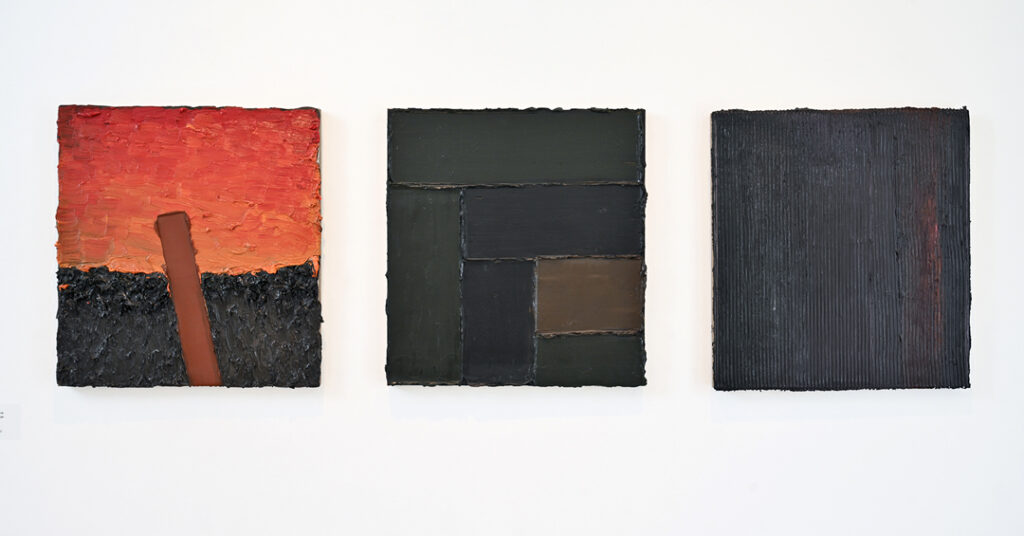
Farid Abu Shakra, Sunflower Field Scarecrow, Partition and Plow, oil paintings. Photo: Shay Ben Efraim
In the oil paintings displayed in the exhibition (“Partition”, “Plow” and “Sunflower Field and Scarecrow”), Abu Shakra uses paint as a raw material and manipulates it in a way that simulates working in the fields, reflected in the names of the paintings. These paintings are completely abstract, and their surface reflects the forces and actions performed on the paint while it was wet. This material act of painting is fundamentally different and is based on movements devoid of refinement. The oil paintings are a direct continuation of a painterly activity with a long tradition (oil painting on canvas), but they also break conventions and represent an agricultural action in a material-form capsule.
The very question, what is between man and his GROUND? in Israel 2024, is loaded with many layers of meaning. Being a Palestinian artist living in Israel and working with soil nowadays draws most of our attention to the extroverted issue of identity, of conflict between Palestinian and Jewish societies. However, Farid Abu Shakra, as an artist, manages to escape the one-dimensional labelling and shows an exhibition that deals with much more than that: it deals with formalist aspects of the relationship between artist and material, with the wisdom of hands and the choice of basic materials: wood, earth, iron. In addition, the exhibition deals with the beauty found in the traditional world and gives it a new interpretation. All these do not blur the questions of identity but strengthen them because first and foremost, the exhibition deals with the humane, humanity in general, art that represents the human, and man everywhere on earth.
✿
Ground? / Farid Abu Shakra Benyamini Contemporary Ceramics Center 18 April – 1 June 2024
Shlomit Bauman (PhD) is a senior Lecturer at the Industrial Design Department of HIT – Holon Institution of Technology. She is a ceramics artist and designer, and she combines research and education. Bauman is the head curator of Benyamini Contemporary Ceramics Center.

